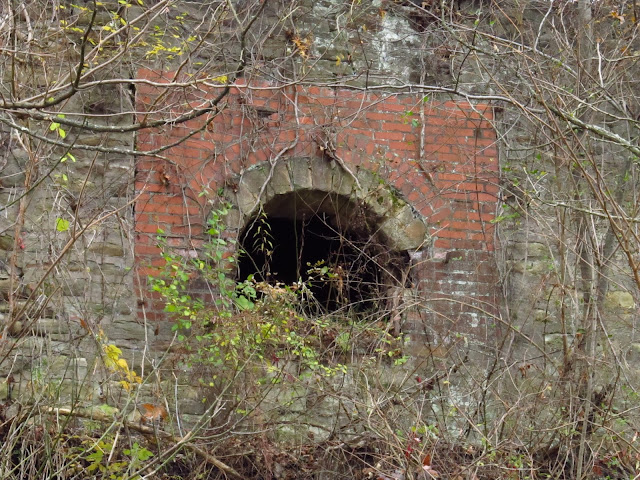The Hoover Coke Works has approximately 79 bank ovens remaining. At one time there was an additional block containing 100 double block ovens but these have been removed. What remains are either in relatively decent condition or are falling apart. At the beginning of the bank, the ovens seem raised. According to the SWPA Rural Exploration website, this area was excavated during the time the mine site was being reclaimed. Towards the middle of the bank it levels out.
These ovens date back to approximately 1908 when James Hoover, a farmer in German Township began mining the Pittsburgh Coal Seam on his property. The Hoover Works closed in 1922 and remained abandoned until 1939 when the Pennsylvania Coal Company, headed by the Noble family (of Shoaf fame, as well as other sites) acquired the property. The Nobles operated the site until 1942. After that the ovens were operated occasionally until finally closing for good in the early 1950's.
Stonework varies on the ovens. Some appear to be original, while others have been altered later with block. At the end of the bank is a room of some sort. It is a brick and stone room with some sort of piping in it and has a hole in the top of one side, almost like a trunnel hole but possibly a chimney hole.
 |
| The beginning of the bank, the "raised" section. |
 |
| In decent condition but too high to climb into. |
 |
| This section, where the ovens begin to fall apart, are almost on a curve. The beginning of the bank starts closer to the road but turns slightly as it progresses. |
 |
| This is where it starts to level off. |
 |
| Part of the old dock wall in front of the ovens. |
 |
| More Garfield crown blocks. The Garfield brick yard was near Bolivar, PA. |
 |
| A bit of hardware. |
 |
| Very high up. |
 |
| Exposing the oven. |
 |
| Some block laying around. |
 |
| Crazy. |
 |
| This wall is across the field from these ovens. I'm assuming it's where the block ovens were located. |
 |
| Inside. |
 |
| This is some of the later block front on these ovens. This occurred sporadically. One could be this type of block and the next could be original stone. |
 |
| This is the room at the end of the bank. |
 |
| Piping inside the room. |
 |
| The hole in the roof. |
 |
| The end of the bank on the room side. |








No comments:
Post a Comment